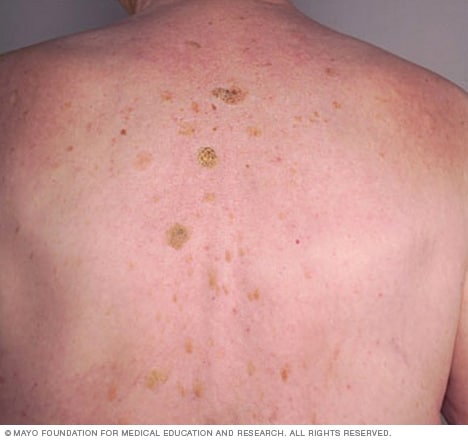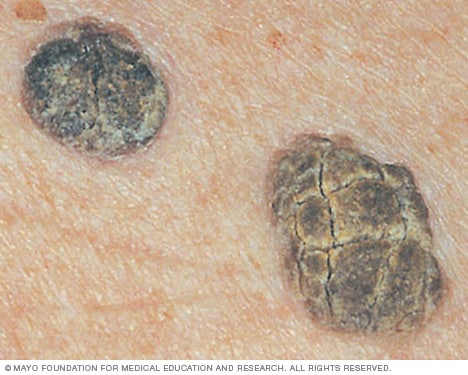Seborrheic keratosis
Overview
A seborrheic keratosis (seb-o-REE-ik ker-uh-TOE-sis) is a common noncancerous (benign) skin growth. People tend to get more of them as they get older.
Seborrheic keratoses are usually brown, black or light tan. The growths (lesions) look waxy or scaly and slightly raised. They appear gradually, usually on the face, neck, chest or back.
Seborrheic keratoses are harmless and not contagious. They don't need treatment, but you may decide to have them removed if they become irritated by clothing or you don't like how they look.


Symptoms
A seborrheic keratosis grows gradually. Signs and symptoms might include:
- A round or oval-shaped waxy or rough bump, typically on the face, chest, a shoulder or the back
- A flat growth or a slightly raised bump with a scaly surface, with a characteristic "pasted on" look
- Varied size, from very small to more than 1 inch (2.5 centimeters) across
- Varied number, ranging from a single growth to multiple growths
- Very small growths clustered around the eyes or elsewhere on the face, sometimes called flesh moles or dermatosis papulosa nigra, common on Black or brown skin
- Varied in color, ranging from light tan to brown or black
- Itchiness
When to see a doctor
See your doctor if the appearance of the growth bothers you or if it gets irritated or bleeds when your clothing rubs against it. Also see your doctor if you notice suspicious changes in your skin, such as sores or growths that grow rapidly, bleed and don't heal. These could be signs of skin cancer.
Causes
Experts don't completely understand what causes a seborrheic keratosis. This type of skin growth does tend to run in families, so there is likely an inherited tendency. If you've had one seborrheic keratosis, you're at risk of developing others.
A seborrheic keratosis isn't contagious or cancerous.
Risk factors
The peak time for developing seborrheic keratoses is after your 50s. You're also more likely to have them if you have a family history of the condition.
Diagnosis
Your doctor can usually tell whether you have a seborrheic keratosis by looking at the affected skin. If there is a question about the diagnosis, your doctor might recommend removing the growth so that it can be examined under a microscope.
Treatment
A seborrheic keratosis typically doesn't go away on its own, but treatment isn't needed. You might choose to have it removed if it becomes irritated or bleeds, or if you don't like how it looks or feels.
Seborrheic keratosis removal can be achieved with one or a combination of the following methods:
- Freezing the growth. Freezing a growth with liquid nitrogen (cryotherapy) can be an effective way to remove a seborrheic keratosis. It doesn't always work on raised, thicker growths. This method carries the risk of permanent loss of pigment, especially on Black or brown skin.
- Scraping (curettage) or shaving the skin's surface. First your doctor will numb the area and then use a scalpel blade to remove the growth. Sometimes shaving or scraping is used along with cryosurgery to treat thinner or flat growths.
- Burning with an electric current (electrocautery). First your doctor will numb the area and then destroy the growth with electrocautery. This method can be used alone or with scraping, especially when removing thicker growths.
Talk with your doctors about the risks and benefits of each method. Some methods can cause permanent or temporary skin discoloration and scarring. After treatment, you might develop a new seborrheic dermatosis elsewhere on your body.
Preparing for your appointment
You're likely to start by seeing your primary care doctor. In some cases when you call to set up an appointment, you may be referred directly to a specialist in skin diseases (dermatologist).
Because appointments can be brief, it's a good idea to be well prepared for your appointment. Here's some information to help you get ready for your appointment.
What you can do
For a seborrheic keratosis, some basic questions to ask your doctor include:
- Are tests needed to confirm the diagnosis?
- What is the best course of action?
- Which treatments might cause scarring or permanent skin discoloration?
- Will the spot go away on its own?
- What will the treatments cost? Does medical insurance cover these costs?
- What suspicious changes in my skin should I look for?
Don't hesitate to ask other questions that come up during your appointment.
What to expect from your doctor
Your doctor may ask:
- When did you first notice the skin lesion?
- Have you noticed multiple growths?
- Have you noticed any changes in the growth?
- Is the condition bothersome?
- Do any family members also have this condition?
Last Updated Jan 18, 2022
© 2024 Mayo Foundation for Medical Education and Research (MFMER). All rights reserved. Terms of Use



